Enrique Arciniegas1*, Héctor Rojas2, Jacinto Pineda3, Andrés Duque1, Roberto Cáceres1, Richard Ramírez4, Antonio Salgado4
1Institute of Biomedicine, Central University of Venezuela, Caracas, Venezuela
2Institute of Immunology, Central University of Venezuela, Caracas, Venezuela
3Institute of Anatomy and Pathology, Central University of Venezuela, Caracas, Venezuela
4Autonomus Service Institute of Biomedicine, Caracas, Venezuela
*Correspondence author: Enrique Arciniegas, Instituto de Biomedicina, Distrito Capital, Caracas 1010, República Bolivariana de Venezuela;
Email: [email protected]
Published Date: 03-12-2024
Copyright© 2024 by Arciniegas E, et al. All rights reserved. This is an open access article distributed under the terms of the Creative Commons Attribution License, which permits unrestricted use, distribution, and reproduction in any medium, provided the original author and source are credited.
Abstract
Angiolipomas are benign subcutaneous nodules characterized by the presence of mature adipocytes intermingled with cluster of small blood vessels, often displaying intraluminal fibrin microthrombi. It is known that fibrinogen and/or fibrin intraluminal and extracellular deposition during immune responses affect Endothelial Cell (EC) functioning and leukocyte trafficking. Also, it is known that Toll-Like Receptors (TLRs) are not only expressed in Immune Cells (ICs) but also in ECs and that excessive endothelial activation through TLR interactions with endogenous ligands such as fibrinogen, Heparan Sulfate Proteoglycans (HSPGs), Fibronectin (FN), Tenascin-C (TN-C), hyaluronan and galectin-3, contributes to EC dysfunction promoting endothelial proliferation, migration, apoptosis and tube-like structures formation. Nevertheless, studies involving the endothelial TLR4 activation by specific ligands and their contribution to the small blood vessels formation in angiolipoma has not been considered.
Herein, we show that in angiolipoma TLR4 and some of their ligands such as fibrinogen, FN, HSPGs including agrin, perlecan and Synd-1 and galectin-3 as well as some glycoconjugates associated to these ligands including VE-cadherin, VCAM-1, ICAM-1, PECAM-1, endoglin and CD44 were immunolocalized in the ECs from the small vessels and some ICs. We propose that in angiolipoma tissues galectin-3 oligomerization upon binding to these TLR4 endogenous ligands and glycoproteins associated can lead to the formation of gal-glycan lattices on the endothelial surface that might be facilitating not only the activation of TLR4, but also contributing to the vasculature formation regulated by signaling pathways mediated by certain cytokines, chemokines and growth factors.
Keywords: Angiolipoma; Fibrin Microthrombi; Endothelial Cell; Toll-Like Receptor 4; Galectin-3; Gal-Glycan Lattice
Introduction
Angiolipomas are benign subcutaneous nodules characterized by the presence of mature adipocytes intermingled with clusters of small blood vessels generally situated at the periphery of the lesion. The clusters are composed in part of well formed, dilated small vessels containing Red Blood Cells (RBCs). Other blood vessels appear tortuous and have poorly formed lumina. Nearly all angiolipomas display intraluminal fibrin microthrombi formed from fibrinogen, being the presence of fibrin microthrombi considered as a diagnostic hallmark of angiolipoma and associated with its painful nature [1-6]. The multidomain glycoprotein fibrinogen, together with fibrin, plays overlapping roles in blood clotting, fibrinolysis, cellular and Extracellular Matrix (ECM) interactions, inflammatory responses, wound healing, angiogenesis and tumorigenesis [7-16]. It is known that fibrinogen and/or fibrin intraluminal and extraluminal deposition during immune responses affect Endothelial Cell (EC) functioning and leukocyte trafficking. Both provoked by inflammatory mediators that include cytokines, chemokines and growth factors [5,8-10,14,16].
Of note, interaction of fibrinogen/fibrin with EC via endothelial integrin receptors including α5β1 and αvβ3 and non-integrin receptors such as Vascular Endothelial-cadherin (VE-cadherin), Neural-cadherin (N-cadherin) and the Intercellular Cell Adhesion Molecule-1 (ICAM-1) inducing the formation of capillary-like structures by human vascular ECs is well documented [7-9,11,14,17-21]. However, despite the presence of intraluminal fibrinogen/fibrin microthrombi in the small blood vessels in angiolipoma is well known, the interaction between fibrinogen/fibrin and ECs has not been clarified.
It has further reported that Toll-Like Receptors (TLRs), a family of innate immune receptors, are not only expressed in immune cells (ICs) but also in ECs [22-32].
TLRs are type I integral membrane glycoproteins that possess a N-terminal extracellular domain containing multiple Leucine-rich repeat (LRR) motifs required for ligand binding, a transmembrane fragment and an intracellular C-terminal binding domain of Toll / Interleukin-1 (IL-1) Receptor (TIR) homology domain [37-42]. In humans, TLRs comprise ten functional members that are expressed on the cell surface (TLR1, 2, 4, 5, 6 and 10) or in the intracellular compartments (TLR3, 7, 8, 9, occasionally TLR4), the TLR4 being one of most studied [37-42]. Notably, TLR4 activation by endogenous components such as fibrinogen, Heparan Sulfate Proteoglycans (HSPGs), Fibronectin (FN), Tenascin-C (TN-C) and hyaluronan, has been suggested [43-50]. In ECs, accumulating evidence suggest that inappropriate or excessive endothelial activation through TLR interactions with endogenous ligands generated upon cellular injury, cell death or stressed tissues (Damage-Associated Molecular Patterns, DAMPs) contributes to endothelial dysfunction promoting endothelial proliferation, migration, apoptosis and tube formation by secretion of cytokines, chemokines and growth factors by both ECs and ICs as well as upregulating the expression of endothelial adhesion molecules and activation of coagulation and NFkB pathways [22-28,31,32,51,52]. Another important endogenous ligand and activator of TLR4 that is expressed and released during the neurodegenerative disorders and other inflammatory diseases is the galectin-3 [53-57]. This chimeric protein that has a great affinity for the β-galactoside residues present in the TLR4 and TLR2 ectodomains through its Carbohydrate Recognition Domain (CRD) and its N-terminal, form dimers and oligomeric structures, respectively [53-62]. The latter structure gives way to galectin-3 molecules with multivalent CRDs that form lattice on the cell surface facilitating cell adhesion and activation [59-62]. Of note, dimeric and oligomeric structures regulate innate and adaptive responses and promote angiogenesis [54,59,63-69]. Nevertheless, to the best of our knowledge, studies involving the endothelial TLR4 activation by specific ligands and their contribution to the small blood vessels (vasculature) formation in angiolipoma, has not been considered.
In this context, the goal of the current study was to examine the presence and localization in angiolipoma tissues of endothelial TLR4 and some of their endogenous ligands including fibrinogen/fibrin, HSPGs, FIBronectin (FN) and galectin-3, as well as of some glycoconjugates associated to these ligands such as Vascular-Endothelial cadherin (VE-cadherin), Intercellular Cell Adhesion Molecule-1 (ICAM-1) (CD54), Vascular Cell-Adhesion Molecule-1 (VCAM-1) (CD106), Platelet Endothelial Cell Adhesion Molecule-1 (PECAM-1 ( CD31), endoglin (CD105) and CD44 and whose upregulation has been related with TLR4 activation. We also discuss the contribution of endothelial TLR4 and their endogenous ligands to the vasculature formation in the angiolipoma.
Material and Methods
Seven biopsies were obtained from patients clinically and histopathologically (H&E staining) diagnosed with angiolipoma. Data regarding gender, age and site of lesion appear listed in Table 1. This study was approved by the Ethics Committee of the ASIB and performed in line with the principles of the Declaration of Helsinki.
Indirect Immunofluorescence Staining of Tissue Sections
For immunohistochemistry paraffin-embedded skin tissue blocks were cut into sections of 4µm of thick each. Paraffin sections were then set onto silanised glass slides, dewaxed in xylene, dehydrated through graded alcohol series (from 100 to 70%) and rehydrated in distilled water and equilibrated in Phosphate-Buffered Saline (PBS) for 10 min. Prior to incubation with the primary antibodies, sections were blocked for 1 hour in a humid chamber with Phosphate-Buffered Saline (PBS) containing 3% BSA and 0.1% Tween 20, in order to prevent non-specific staining. Sections were then incubated with the primary antibodies diluted in PBS, 3% BSA, 0.1% Tween 20 (Table 2) for two hours at RT followed by incubation with anti-rabbit IgG Cruz Fluor 594 (Santa Cruz Biotechnology Inc. TX, USA) diluted with PBS containing 3% BSA and 0.1% Tween20 for 30 min in a humid chamber in the dark. Finally, the sections were washed in PBS and coverslipped with mounting medium containing DAPI (4´, 6-Diamidino-2-phenylindole) (Santa Cruz Biotechnology).
For autofluorescence, selected sections of 4µm dewaxed and without staining were examined with the CLSM. Autofluorescence was determined from the ratio between the emission fluorescence in the wavelength range between 603 and 646nm and the excitation light with a wavelength of between 491 and 592 nm. To validate antibody binding specificity, some sections were incubated with only primary antibody or secondary antibody. All images were captured using a 1X81 Olympus inverted microscope with the Fluo View Confocal Laser Scanning configuration (CLSM) (Olympus America) equipped with software program FV10.ASW.
Results
Histopathological analysis of the angiolipoma tissue sections showed the presence of dilated and tortuous small blood vessels intermingled with mature adipocytes that were situated in the periphery of the lesion (Fig. 1). Intraluminal microthrombi consisting of fibrinogen/fibrin strands and Red Blood Cells (RBCs) were also frequently observed in numerous vessels (Fig. 1). These microthrombi generally appeared delimited by Endothelial Cells (ECs) and some ICs (Fig. 2). Yellow dotted lines enclosed dilated and tortuous blood vessels.
In-vivo PECAM-1 (CD31) Immunostaining
Because PECAM-1 is a transmembrane glycoprotein with pro-inflammatory and pro-angiogenic activities highly expressed on the surface of activated Endothelial Cells (ECs), we examined the presence and distribution of this glycoprotein in the small blood vessels of angiolipoma [70,71]. Immunofluorescence analysis by confocal microscopy showed that PECAM-1 was localized in the ECs of the tortuous and dilated small blood vessels (Fig. 3). In addition, moderate PECAM-1 immunoreactivity was observed in some ICs (Fig. 3). Exacerbated immunopositivity in RBCs, ICs and microthrombi provoked by autofluorescence at the red wavelength was also observed (Supplemental Fig. 1).
In-vivo Perilipin 1 (PLIN1) Immunostaining
As PLIN1 is a lipid droplet-associated protein that is considered specific biomarker of adipocytes, we examined la presence and localization of this protein in the angiolipoma tissue sections [72]. Immunofluorescence showed mature adipocytes containing PLIN1 (Fig. 4).
In-vivo VE-cadherin, ICAM-1 (CD54) and VCAM-1 (CD106) Immunostaining
Since VE-cadherin, ICAM-1 (CD54) and VCAM-1 (CD106) are glycoproteins that mediate the interaction of fibrinogen/fibrin with ECs modulating fibrin-dependent inflammation and angiogenesis and given that exaggerated endothelial TLR4 activation can induce the expression of ICAM-1 and VCAM-1, we examined the presence and localization of these glycoproteins in the small blood vessels of angiolipoma tissue sections [7,9,16,19,20,24,27,31,32]. Immunofluorescence showed that ICAM-1 and VCAM-1 were localized in the ECs of the dilated and tortuous small blood vessels (Fig. 5).
In-vivo Toll-Like Receptor 4 (TLR4) Immunostaining
Considering that exaggerated activation of TLR4 contributes to endothelial dysfunction, mediating immune response and angiogenesis and can induce the expression of ICAM-1 and VCAM-1, we tested the presence and distribution of this receptor in angiolipoma tissue sections [22-32]. Strong TLR4 staining was observed in the ECs of the dilated and tortuous small blood vessels, as well as in some adipocytes (Fig. 6) and some immunopositive CD68 ICs (Fig. 6). No immunoreactivity was detected when the primary antibody was omitted or replaced by PBS (not shown).
In-vivo Fibronectin (FN), Syndecan-1 (Synd-1), Agrin, Perlecan and CD44 Immunostaining
We next examined the presence and localization of the glycoprotein FN, a glycoprotein that interacts with fibrinogen/fibrin, HSPGs agrin, perlecan and Synd-1 (CD138) and the CSPG CD44 [73,74]. Proteoglycans involved in the angiogenic and proliferative responses in ECs and considered endogenous activators of TLR4 [27,33-36,42-50]. We found that FN, agrin, perlecan, Synd-1 and CD44 were present in the small blood vessels, in some ICs, as well as in the extracellular space (Fig 7).
In-vivo Galectin-3 Immunostaining
Because galectin-3, a glycan-binding protein, has been identified as another important endogenous ligand and activator of TLR4, we also examined the localization and distribution of this galectin in the small blood vessels of angiolipoma tissue sections [53-58]. Immunofluorescence evidenced immunoreactivity for galectin-3 in the ECs of small blood vessels (Fig. 8). Likewise, galectin-3 was observed in some adipocytes and ICs (Fig. 8).
In-vivo Galectin-3 Immunostaining
Because galectin-3, a glycan-binding protein, has been identified as another important endogenous ligand and activator of TLR4, we also examined the localization and distribution of this galectin in the small blood vessels of angiolipoma tissue sections [53-58]. Immunofluorescence evidenced immunoreactivity for galectin-3 in the ECs of small blood vessels (Fig. 8). Likewise, galectin-3 was observed in some adipocytes and ICs (Fig. 8).
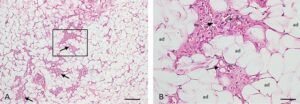
Figure 1: (A,B) Hematoxylin (H&E) staining from a biopsy of angiolipoma tissue located on thigh, showing the presence of dilated and tortuous small blood vessels containing intraluminal microthrombi (arrows), ICs (arrowhead) and RBCs (asterisk), intermingled with mature adipocytes (ad). ec, endothelial cell. Scale bars: 375 µm (A); 75 µm (B).
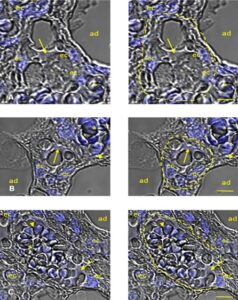
Figure 2: Differential interference contrast (DIC) images from two biopsies of angiolipoma tissues (A, arm; B,C, thigh). Note the presence of intraluminal microthrombi (arrows) delimited by ECs (ec), some ICs (arrowhead) and RBCs (asterisks). Yellow dotted lines enclose the small blood vessels. Blue, nuclear DAPI staining. Scale bars: 15 µm (A); 25 µm (B.C).
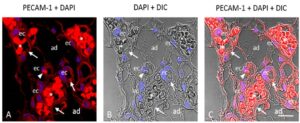
Figure 3: CLSM images of PECAM-1 (CD31) in the angiolipoma tissue located on thigh. (A,C) PECAM-1 (CD31) immunolocalization in the ECs (ec) of the tortuous and dilated small blood vessels containing intraluminal microthrombi (arrows), as well as in some ICs (arrowhead). Blue, nuclear DAPI staining. (B,C) DIC, differential interference contrast images. (C) Merge of images. Scale bar: 75 µm. ad, mature adipocytes; RBCs (asterisks).
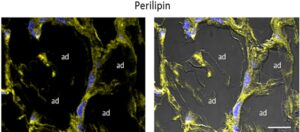
Figure 4: CLSM fluorescence image of perilipin in the same biopsy. Perilipin is immunolocalized in the mature adipocytes (ad). Blue, nuclear DAPI staining. Scale bar: 75µm. The corresponding overlay of fluorescence and DIC images is shown.

Figure 5: CLSM fluorescence image of VE-cadherin in the biopsy of angiolipoma located on thigh and ICAM-1 (CD54) and VCAM-1(CD106) in the biopsy of angiolipoma located on arm. VE-cadherin, ICAM-1 (CD54) and VCAM-1 (CD106) were immunolocalized in the ECs (ec) of the tortuous and dilated small blood vessels containing intraluminal microthrombi (arrows), as well as in some ICs (arrowhead). Blue, nuclear DAPI staining. DIC, differential interference contrast image. Scale Bar: 75µm. ad, mature adipocytes; RBCs (asterisks).
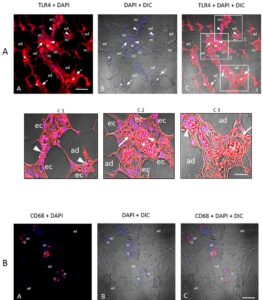
Figure 6: (A) CLSM images of TLR4 in the biopsy of angiolipoma located on thigh. (A,C) TLR4 immunolocalization in the ECs (ec) of the tortuous and dilated small blood vessels containing intraluminal microthrombi (arrows), as well as in some ICs (arrowhead) and some mature adipocytes (ad). Blue, nuclear DAPI staining. (B,C) DIC, differential interference contrast images. (C) Merge of images. Scale bar: 90 µm. RBCs (asterisks). Enlargements (C1,C2,C3) show the immunoreactivity in the ECs (ec), some ICs (arrowheads) and mature adipocytes (ad). Blue, nuclear DAPI staining. Scale bar: 45 µm. (B) CLSM images of CD68 in the same biopsy. (A,C) CD68 immunolocalization in ICs. Blue, nuclear staining. (B,C) DIC, differential interference contrast images. (C) Merge of images. Scale bar: 90 µm.
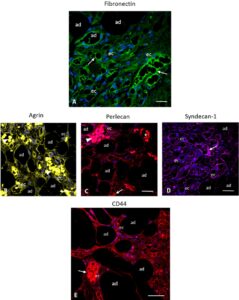
Figure 7: A serie of representative CLSM fluorescence images of FN, agrin, perlecan, syndecan-1 and CD44 in a biopsy of angiolipoma located on arm. Immunoreactivities are observed in the small blood vessels, in some ICs (arrowheads), as well as in the extracellular space. Blue, nuclear DAPI staining. Scale bars: 50 µm; 75 µm. ec, endothelial cell; intraluminal microthrombi (arrows); ad, mature adipocyte. RBCs (asterisk).

Figure 8: Immunolocalization of galectin-3 in the biopsy of angiolipoma located on thigh. Galectin-3 immunoreactivity is observed in the ECs (ec) of small blood vessels containing intraluminal microthrombi (arrows) as well as in some ICs (arrowheads) and mature adipocytes (ad). Blue, nuclear DAPI staining. DIC, differential interference contrast. Enlargements (1,2) show the galectin-3 immunoreactivity in the ECs (ec), ICs (arrowheads) and mature adipocytes (ad). Scale bars: 75 µm; 20 µm.
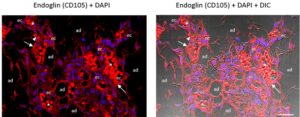
Figure 9: CLSM fluorescence image of endoglin (CD105) in the same biopsy. Endoglin is immunolocalized in the ECs (ec) of the tortuous and dilated small blood vessels containing intraluminal microthrombi (arrows), as well as in some ICs (arrowhead). Blue, nuclear DAPI staining. DIC, differential interference contrast image. Scale Bar: 40µm. ad, mature adipocytes; RBCs (asterisks). The corresponding overlay of fluorescence and DIC images is shown.
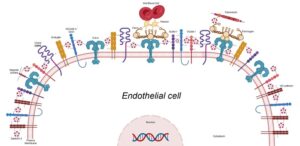
Figure 10: Schematic representation of galectin-3 forming a gal-glycan lattice on the endothelial surface with activated TLR4 and some of its endogenous ligands that include fibrinogen/fibrin, HSPGs and FN, as well as with some glycoconjugates associated to these ligands such as VE-cadherin, PECAM-1 (CD31), ICAM-1 (CD54), VCAM-1 (CD106), endoglin (CD105) and CD44.
Patient | Gender | Age | Site of Lesion |
1 | Female | 41 years | Thigh |
2 | Male | 62 years | Thigh |
3 | Female | 48 years | Arm |
4 | Male | 24 years | Arm |
5 | Male | 38 years | Wrist |
6 | Female | 48 years | Scapular region |
7 | Male | 28 years | Arm |
Table 1: Patients diagnosed with angiolipoma included in the study.
Primary Antibody | Host | Producer |
Agrin | Mouse monoclonal | Santa Cruz Biotechnology, Inc., Dallas, TX, USA |
CD44 | Mouse monoclonal | Santa Cruz Biotechnology, Inc., Dallas, TX, USA |
CD68 | Mouse monoclonal | Santa Cruz Biotechnology, Inc., Dallas, TX, USA |
Endoglin (CD105) | Mouse monoclonal | Santa Cruz Biotechnology, Inc., Dallas, TX, USA |
Fibronectin | Mouse monoclonal | Santa Cruz Biotechnology, Inc., Dallas, TX, USA |
Galectin-3 | Mouse monoclonal | Santa Cruz Biotechnology, Inc., Dallas, TX, USA |
ICAM-1 (CD54) | Mouse monoclonal | Santa Cruz Biotechnology, Inc., Dallas, TX, USA |
PECAM-1(CD31) | Mouse monoclonal | Santa Cruz Biotechnology, Inc., Dallas, TX, USA |
Perilipin (PLIN1) | Mouse monoclonal | Santa Cruz Biotechnology, Inc., Dallas, TX, USA |
Perlecan | Mouse monoclonal | Santa Cruz Biotechnology, Inc., Dallas, TX, USA |
Syndecan-1 (CD138) | Mouse monoclonal | Santa Cruz Biotechnology, Inc., Dallas, TX, USA |
TLR4 | Mouse monoclonal | Santa Cruz Biotechnology, Inc., Dallas, TX, USA |
VCAM-1 (CD106) | Mouse monoclonal | Santa Cruz Biotechnology, Inc., Dallas, TX, USA |
VE-cadherin | Mouse monoclonal | Santa Cruz Biotechnology, Inc., Dallas, TX, USA |
Table 2: Antibodies.
Discussion
In this study, we showed the presence of intraluminal fibrinogen/fibrin microthrombi delimited by ECs that exhibited immunoreactivities to VE-cadherin, ICAM-1 (CD54), VCAM-1 (CD106), PECAM-1 (CD31) and endoglin (CD105) and by some immunopositive CD68 ICs that also displayed ICAM-1, PECAM-1 and endoglin immunoreactivities in the small blood vessels of angiolipoma (arterioles, capillary-like structures and venules). In this regard, several reports in vascular ECs have established that fibrinogen/fibrin directly interacts with ECs through VE-cadherin, ICAM-1 and VCAM-1, operating as bridging molecule and facilitating the formation of capillary-like structures and promoting angiogenesis [7-10,16-20]. The same studies suggest that fibrinogen endothelial binding also increases the expression of growth factors such as FGF-2 and VEGF and inflammatory cytokines including Interleukin-β1 (IL-β1) and Tumor Necrosis Factor-α (TNF-α) stimulating inflammatory response and angiogenesis [8-10,16]. Similarly, fibrinogen binding to ICAM-1 has been shown to enhance IC-endothelium interaction with the participation of VE-cadherin, promoting leukocyte transmigration and inflammation [12,16,78]. Thus, it is likely that fibrinogen and fibrin serves a scaffold of glycoproteins that could be facilitating the EC-EC and IC-EC interactions through VE-cadherin, ICAM-1, VCAM-1, PECAM-1 and in turn, contributing to the vasculature formation in angiolipoma [7,11,13,21].
Of relevance, binding of fibrinogen/fibrin to TLR4 triggering the TLR4 activation and promoting inflammatory response and angiogenesis has been suggested [12,25,27,78]. Moreover, fibrinogen/fibrin effects have been associated with TLR4 signaling. In fact, there is evidence that fibrinogen stimulates monocyte/macrophage chemokine secretion at sites of inflammation through TLR4 activation [25,27,79]. Noteworthy, studies have highlighted that inappropriate endothelial activation through TLR4 contributes not only to initial microthrombus formation, but also to endothelial dysfunction [26-28,32,51]. The same studies propose that TLR4 raised the levels of Tissue Factor (TF), a blood clotting protein that contributes to thrombus formation [26-28,32,51]. In this context, other studies report that exaggerated activation of TLR4 can induce the expression of endothelial adhesion ICAM-1 and VCAM-1 [24,26,27,31,32,36]. In line with these reports, elevated mRNA levels expression of ICAM-1, VCAM-1 and E-selectin by microvascular ECs in response to TLR4 has been demonstrated [23,24,28,36]. Furthermore, inappropriate activation of endothelial TLR4 and up-regulation of endoglin expression promoting endothelial dysfunction and contributing to inflammation and angiogenesis has been proposed [77]. However, despite it has been suggested that inappropriate activation of ECs through TLR4 could contribute to tissue damage and defective angiogenesis, the mechanisms underlying the interaction of ECs with TLR4 are still being explored [26,28,29,32].
In this study, immunofluorescence staining revealed that TLR4 and some of their endogenous ligands such as such as FN, HSPGs including agrin, perlecan and Synd-1, as well as the glycoconjugates associated to these ligands such as VE-cadherin, VCAM-1, ICAM-1, PECAM-1, endoglin and CD44 were localized in the ECs from the small vessels and some ICs. Incidentally, studies on ECs and TLR4 activation have proposed that excessive TLR4 activation by endogenous ligands including ECM components such as fibrinogen, FN, HSPGs, TN-C and hyaluronan, contribute to endothelial dysfunction promoting endothelial proliferation, migration, apoptosis and tube-like structures formation, involving upregulation of ICAM-1 and VCAM-1 expression and secretion of cytokines, chemokines and growth factors [24,25,27,32]. Similarly, studies on inflammation, angiogenesis and TLRs have suggested that endothelial dysfunction via TLRs interaction with endogenous ligands generated upon cellular injury, cell death or stressed tissues contributes to inflammation and angiogenesis [23,26-28,31]. Therefore, it is likely that the endothelial TLR4 endogenous ligands contribute not only to the activation of TLR4 but also to the vasculature formation in angiolipoma. With respect to Gal-3, another important endogenous ligand and activator of TLR4, immunofluorescence also evidenced immunoreactivity for galectin-3 in the ECs of small vessels as well as in some ICs. Consistent with this, studies on galectin-3 have suggested that this glycan-binding protein has a great affinity for the β-galactoside residues present in the TLR4 and TLR2 ectodomains regulating innate and adaptive responses and promoting inflammatory response and angiogenesis [54,58]. Remarkably, studies have point to the involvement of galectin-3 in the leukocyte recruitment in-vivo and angiogenesis [54,59,63-69]. Furthermore, galectin-3 oligomerization upon binding to glycoconjugates containing β-galactoside residues on EC surface such as Synd-1, CD44, ICAM-1, VCAM-1, VE-cadherin, N-cadherin, PECAM-1 and endoglin has been proposed, suggesting a critical role for galectin-3 in endothelial morphogenesis and angiogenesis [59,65,68,80]. This is interesting if we consider that published evidence indicates that galectin-3 oligomerization can generate galectin-lattices on the endothelial surface and ICS which facilitate endothelial activation, migration, proliferation and tubule-like structures formation [68,69,80-82]. What is more, the glycoconjugates above mentioned, including fibrinogen, in addition to being assumed as endogenous ligands and activators of endothelial TLR4 are also considered as potential binding partners for galectin-3, as they contain N- and O-linked glycan residues in their ectodomains [24,25,27,32,80,82].
Conclusion
Therefore, it is possible that in angiolipoma tissues galectin-3 oligomerization can lead to the formation of gal-glycan lattices on the endothelial surface that might be facilitating not only the activation of endothelial TLR4, but also contributing to the vasculature formation regulated by signaling pathways mediated by certain cytokines, chemokines and growth factors (Fig.10).
Conflict of Interest
The authors declared no potential conflicts of interest with respect to the research, authorship and/or publication of this article.
Acknowledgements
The authors thank Biba Arciniegas-Mata for English-editing of this manuscript.
This work was supported by grant N°2023PGP61 from Fondo Nacional de Ciencia, Tecnología e Innovación (FONACIT).
Author Contributions
E.A. analyzed the data and wrote the paper; H.R., A.D., A.S. and R.R. analyzed the data and constructed the images; A.D. constructs the scheme; J.P. and R.C. examined the biopsies. All authors read and approved the final manuscript.
References
- Alonso S, Rodríguez-Peralto JL, Pérez-Espejo G. Metastasis of cutaneous malignant melanoma to angiolipoma: the tumor-to-tumor metastasis phenomenon. J Cutan Pathol. 2003;30(5):323-5.
- Lapidoth M, Ben Amitai D, Feinmesser M, Akerman L. Capillary malformation associated with angiolipoma: analysis of 127 consecutive clinic patients. Am J Clin Dermatol. 2008;9(6):389-92.
- Heng W, Lu L, Wang J. Cellular angiolipoma: a clinicopathological and immunohistochemical study of 12 cases. Am J Dermatopathol. 2013;35(2):220-5.
- Saggini A, Santonja C, Nájera L, Palmedo G, Kutzner H. Frequent activating PIK3CA mutations in sporadic angiolipoma. J Cutan Pathol. 2021;48(2):211-6.
- Díaz-Flores L, Gutiérrez R, Pino García M, González-Gómez M, Díaz-Flores L Jr, Carrasco Jl, et al. Intussusceptive angiogenesis facilitated by microthrombosis has an important example in angiolipoma. An ultrastructural and immunohistochemical study. Histol Histopathol. 2023;38(1):29-46.
- Kransdorf MJ, Larsen BT, Goulding, KA, Cumsky JL, Hwang S, Long J. Angiolipoma: a review of 778 lesions in 344 patients. Skeletal Radiol. 2023;52(3):541-52.
- Martinez, J, Ferber A, Bach TL, Yaen CH. Interaction of fibrin with VE-cadherin. Ann N Y Acad Sci. 2001;936:386-405.
- Van Hinsbergh VW, Collen A, Koolwijk P. Role of fibrin matrix in angiogenesis. Ann N Y Acad Sci. 2001;936:426-37.
- Mosesson MW. Fibrinogen and fibrin structure and functions. J Thromb Haemost. 2005; 3(8):1894-904.
- Laurens N, Koolwijk P, de Maat MP. Fibrin structure and wound healing. J Thromb Haemost. 2006;4(5):932-9.
- Lord ST. Fibrinogen and fibrin: scaffold proteins in hemostasis. Curr Opin Hematol. 2007;14(3):236-41.
- Jennewein C, Tran N, Paulus P, Ellinghaus P, Eble JA, Zacharowski K. Novel aspects of fibrin(ogen) fragments during inflammation. Mol Med. 2011;17(5-6):568-73.
- Morin KT, Tranquillo RT. In-vitro models of angiogenesis and vasculogenesis in fibrin gel. Exp Cell Res. 2013;319(16):2409-17.
- Luyendyk JP, Schoenecker JG, Flick MJ. The multifaceted role of fibrinogen in tissue injury and inflammation. Blood. 2019;133(6):511-20.
- Cantero M, Rojas H, Anglés-Cano E, Marchi R. Fibrin γ/γ’ influences the secretion of fibrinolytic components and clot structure. BMC Mol Cell Biol. 2019;20(1):47.
- Yakovlev S, Strickland DK, Medved L. Current view on the molecular mechanisms underlying fibrin(ogen)-dependent inflammation. Thromb Haemost. 2022;122(11):1858-68.
- Medved L, Weisel JW. The story of the fibrin(ogen) αC-domains: evolution of our view on their structure and interactions. Thromb Haemost. 2022;122(8):1265-78.
- Collen A, Koolwijk P, Kroon M, van Hinsbergh VW. Influence of fibrin structure on the formation and maintenance of capillary-like tubules by human microvascular endothelial cells. Angiogenesis. 1998;2(2):153-65.
- Bach, TL, Barsigian C, Chalupowicz DG, Busler D, Yaen CH, Grant DS, et al. VE-Cadherin mediates endothelial cell capillary tube formation in fibrin and collagen gels. Exp Cell Res. 1998;238(2):324-34.
- Yakovlev S, Medved L. Interaction of fibrin(ogen) with the endothelial cell receptor VE-cadherin: localization of the fibrin-binding site within the third extracellular VE-cadherin domain. Biochemistry. 2009;48(23):5171-9.
- Yakovlev S, Tjandra N, Strickland DD, Medved L. Identification of neural (N)-cadherin as a novel endothelial cell receptor for fibrin and localization of the complementary binding sites. Biochemistry. 2024;63(2):202-11.
- Fitzner N, Clauberg S, Essmann F, Liebmann J, Kolb-Bachofen V. Human skin endothelial cells can express all 10 TLR genes and respond to respective ligands. Clin Vaccine Immunol. 2008;15(1):138-46.
- Grote K, Schütt H, Schieffer B. Toll-like receptors in angiogenesis. Scientific World Journal. 2011;11:981-91.
- Lu Z, Li Y, Jin J, Zhang X, Lopes-Virella MF, Huang Y. Toll-like receptor 4 activation in microvascular endothelial cells triggers a robust inflammatory response and cross talk with mononuclear cells via interleukin-6. Arterioscler Thromb Vasc Biol. 2012;32(7):1696-706.
- Murad S. Toll-like receptor 4 in inflammation and angiogenesis: a double-edged sword. Front Immunol. 2014;5:313.
- Salvador B, Arranz A, Francisco S, Cordoba L, Punzón C, Llamas MA, et al. Modulation of endothelial function by Toll like receptors. Pharmacol Res. 2016;108:46-56.
- Bhagwani A, Thompson AAR, Farkas L. When innate immunity meets angiogenesis-the role of Toll-like receptors in endothelial cells and pulmonary hypertension. Front Med. 2020;7:352.
- Wang Y, Song E, Bai B, Vanhoutte PM. Toll-like receptors mediating vascular malfunction: Lessons from receptor subtypes. Pharmacol Ther. 2016;158:91-100.
- Stawski L, Marden G, Trojanowska M. The activation of human dermal microvascular cells by poly(I:C), lipopolysaccharide, imiquimod, and ODN2395 is mediated by the Fli1/FOXO3A pathway. J Immunol. 2018;200(1):248-59.
- Sluiter TJ, van Buul JD, Huveneers S, Quay PHA, de Vries MR. Endothelial barrier function and leukocyte transmigration in atherosclerosis. Biomedicines. 2021;9(4):328.
- Jin M, Fang J, Wang JJ, Shao X, Xu SM, Liu PQ, et al. Regulation of Toll-Like Receptor (TLR) signaling pathways in atherosclerosis: from mechanisms to targeted therapeutics. Acta Pharmacol Sin. 2023;44(12):2358-75.
- Stierschneider A, Wiesner C. Shedding light on the molecular and regulatory mechanisms of TLR4 signaling in endothelial cells under physiological and inflamed conditions. Front Immunol. 2023;14:1264889.
- Akira S, Takeda K, Kaisho T. Toll-like receptors: critical proteins linking innate and acquired immunity. Nat Immunol. 2001;2(8):675-80.
- Bell JK, Mullen GE, Leifer CA, Mazzoni A, Davies DR, Segal DM. Leucine-rich repeats and pathogen recognition in Toll-like receptors. Trends Immunol. 2003;24(10):528-33.
- Yu L, Wang L, Chen S. Endogenous toll-like receptor ligands and their biological significance. J Cell Mol Med. 2010;14(11):2592-603.
- Chang ZL. Important aspects of Toll-like receptors, ligands and their signaling pathways. Inflamm Res. 2010;59(10):791-808.
- Ermertcan AT, Öztürk F, Gündüz K. Toll-like receptors and skin. J Eur Acad Dermatol Venereol. 2011;25(9):997-1006.
- Behzadi P, García-Perdomo HA, Karpiński TM. Toll-Like receptors: general molecular and structural biology. J Immunol Res. 2021;9914854.
- Asami J, Shimizu T. Structural and functional understanding of the toll-like receptors. Protein Sci. 2021;30(4):761-72.
- Duan T, Du Y, Xing C, Wang HY, Wang RF. Toll-like receptor signaling and its role in cell-mediated immunity. Front Immunol. 2022;13,812774.
- Bzówka M, Bagrowska W, Góra A. Recent advances in studying Toll-like receptors with the use of computational methods. J Chem Inf Model. 2023;63(12):3669-87.
- Kim HJ, Kim H, Lee JH, Hwangbo C. Toll-Like Receptor 4 (TLR4): new insight immune and aging. Immun Ageing. 2023;20(1),67.
- Okamura Y, Watari M, Jerud ES, Young DW, Ishizaka ST, Rose J, et al. The extra domain A of fibronectin activates Toll-like receptor 4. J Biol Chem. 2001; 276(13):10229-33.
- Beg AA. Endogenous ligands of Toll-like receptors: implications for regulating inflammatory and immune responses. Trends Immunol. 2002;23(11):509-12.
- Johnson GB, Brunn GJ, Kodaira Y, Platt JR. Receptor-mediated monitoring of tissue well-being via detection of soluble heparan sulfate by Toll-like receptor 4. J Immunol. 2002;168(10):5233-39.
- Takeda K, Kaisho T, Akira S. Toll-like receptors. Annu Rev Immunol. 2003;21:335-76.
- Taylor KR, Trowbridge JM, Rudisill J A, Termmer CC, Simon JC, Gallo RL. Hyaluronan fragments stimulate endothelial recognition of injury through TLR4. J Biol Chem. 2004;279(17):17079-84.
- Akira S, Uematsu S, Takeuchi O. Pathogen recognition and innate immunity. Cell. 2006;124(4):783-801.
- Midwood K, Sacre S, Piccinini AM, Inglis J, Trebaul A, Chan E, et al. Tenascin-C is an endogenous activator of Toll-like receptor 4 that is essential for maintaining inflammation in arthritic joint disease. Nat Med. 2009;15(7):774-80.
- Kawai T, Akira S. The role of pattern-recognition receptors in innate immunity: update on Toll-like receptors. Nat Immunol. 2010;11(5):373-84.
- Ren M, Li R, Luo M, Chen N, Deng X, Yan K, et al. Endothelial cells but not platelets are the major source of Toll-like receptor 4 in the arterial thrombosis and tissue factor expression in mice. Am J Physiol Regul Integr Comp Physiol. 2014;307(7):R901-7.
- Menghini R, Campia U, Tesauro M, Rovella V, Rodia G, Schinzari F, et al. Toll-like receptor 4 mediates endothelial cell activation through NF-κB but is not associated with endothelial dysfunction in patients with rheumatoid arthritis. PLoS One. 2014;9(6),e99053.
- Burguillos MA, Svensson M, Schulte T,Boza-Serrano A, García-Quintanilla A, Kavanah E, et al. Microglia-secreted galectin-3 acts as a Toll-like receptor 4 ligand and contributes to microglial activation. Cell Rep. 2015;10(9):1626-38.
- Díaz-Alvarez L, Ortega E. The many roles of galectin-3, a multifaceted molecule in innate immune responses against pathogens. Mediators Inflamm. 2017.
- García-Revilla J, Boza-Serrano A, Espinosa-Oliva AM, Soto MS, Deierborg T, Ruiz R, et al. Galectin-3, a rising star in modulating microglia activation under conditions of neurodegeneration. Cell Death Dis. 2022;13(7):628.
- Ge MM, Chen N, Zhou YQ, Yang H, Tian Y-K, Ye D-W. Galectin-3 in microglia-mediated neuroinflammation: implications for central nervous system diseases. Curr Neuropharmacol. 2022;20(11):2066-80.
- Liang T, Zhu Z, Gong F, Yang X, Lei X, Lu L. Galectin-3 promotes brain injury by modulating the phenotype of microglia via binding TLR-4 after intracerebral hemorrhage. Aging. 2023;15(17):9041-58.
- Joeh E, O’Leary T, Li W, Hawkins R, Hung J, Parker CG, et al. Mapping glycan-mediated galectin-3 interactions by live cell proximity labeling. Proc Natl Acad Sci U S A. 2020;117(44):27329-38.
- Nangia-Makker P, Honjo Y, Sarvis R, Akahani S, Hogan V, Pienta KJ, et al. Galectin-3 induces endothelial cell morphogenesis and angiogenesis. Am J Pathol. 2000;156(3):899-909.
- Ahmad N, Gabius HJ, André S, Kaltner H, Sabesan S, Roy R, et al. Galectin-3 precipitates as a pentamer with synthetic multivalent carbohydrates and forms heterogeneous cross-linked complexes. J Biol Chem. 2004;279(12):10841-47.
- Zhao Z, Xu X, Cheng H, Miller MC, He Z, Gu H, et al. Galectin-3 N-terminal tail prolines modulate cell activity and glycan-mediated oligomerization/phase separation. Proc Natl Acad Sci USA. 2021;118(19),e2021074118.
- Nieminen J, Kuno A, Hirabayashi J, Sato S. Visualization of galectin-3 oligomerization on the surface of neutrophils and endothelial cells using fluorescence resonance energy transfer. J Biol Chem. 2007;282(2):1374-83.
- Sato S, St-Pierre C, Bhaumik P, Nieminen J. Galectins in innate immunity: dual functions of host soluble beta-galactoside-binding lectins as Damage-Associated Molecular Patterns (DAMPs) and as receptors for Pathogen-Associated Molecular Patterns (PAMPs). Immunol Rev. 2009;230(1):172-87.
- Rabinovich GA, Toscano MA. Turning ‘sweet’ on immunity: galectin-glycan interactions in immune tolerance and inflammation. Nat Rev Immunol. 2009;9(5):338-52.
- Gittens BR, Bodkin JV, Nourshargh S, Perretti M, Cooper D. Galectin-3: a positive regulator of leukocyte recruitment in the inflamed microcirculation. J Immunol. 2017;198(11):4458-69.
- Lightfoot A, McGettrick HM, Iqbal AJ. Vascular endothelial galectins in leukocyte trafficking. Front Immunol. 2021;12:687711.
- Liu FT, Stowell SR. The role of galectins in immunity and infection. Nat Rev Immunol. 2023;23(8):479-94.
- Thijssen VL. Galectins in endothelial cell biology and angiogenesis: The Basics. Biomolecules. 2021;11(9):1386.
- Mariño KV, Cagnoni AJ, Croci DO, Rabinovich GA. Targeting galectin-driven regulatory circuits in cancer and fibrosis. Nat Rev Drug Discov. 2023;22(4):295-316.
- DeLisser HM, Christofidou-Solomidou M, Strieter RM, Burdick MD, Robinson CS, Wexler R, et al. Involvement of endothelial PECAM-1/CD31 in angiogenesis. Am J Pathol. 1997; 151(3):671-77.
- Kitazume S, Imamaki R, Ogawa K, Taniguchi N. Sweet role of platelet endothelial cell adhesion molecule in understanding angiogenesis. Glycobiology. 2014;24(12):1260-4.
- Itabe H, Yamaguchi T, Nimura S, Sasabe N. Perilipins: a diversity of intracellular lipid droplet proteins. Lipids Health Dis. 2017;16, 83.
- Pankov R, Yamada KM. Fibronectin at a glance. J Cell Sci. 2002;115:3861-3.
- Makogonenko E, Tsurupa G, Ingham K, Medved L. Interaction of fibrin(ogen) with fibronectin: further characterization and localization of the fibronectin-binding site. Biochemistry. 2002; 41(25):7907-13.
- ten Dijke P, Goumans MJ, Pardali E. Endoglin in angiogenesis and vascular diseases. Angiogenesis. 2008;11(1):79-89.
- Schoonderwoerd MJA, Goumans MTH, Hawinkels LJAC. Endoglin: beyond the endothelium. Biomolecules. 2020;10(2):289.
- Wladis EJ, Carlson JA, Wang MS, Bhoiwala DP, Adam, AP. Toll-like receptors and vascular markers in ocular rosacea. Ophthalmic Plast Reconstr Surg. 2013;29(4):290-3.
- Altieri D. Regulation of leukocyte-endothelium interaction by fibrinogen. Thromb Haemost. 1999;82(2):781-6.
- Smiley ST, King JA, Hancock WW. Fibrinogen stimulates macrophage chemokine secretion through toll-like receptor 4. J Immunol. 2001;167(5):2887-94.
- Arciniegas E, Carrillo LM, Rojas H, Pineda J, Ramírez R, Reyes O, et al. Plump endothelial cells integrated into pre-existing venules contribute to the formation of ‘mother’ and ‘daughter’ vessels in pyogenic granuloma: possible role of galectin-1, -3 and -8. Scars Burn Heal. 2021; 7:2059513120986687.
- Garner OB, Baum LG. Galectin-glycan lattices regulate cell-surface glycoprotein organization and signalling. Biochem Soc Trans. 2008;36(6):1472-77.
- Troncoso MF, Elola MT, Blidner, Sarrias L, Espelt MV, Rabinovich GA. The universe of galectin-binding partners and their functions in health and disease. J Biol Chem. 2023;299(12):105400.
Supplementary File
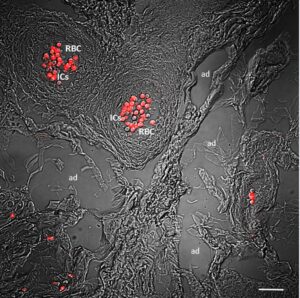
Figure S1: Autofluorescence at the red wavelength.
Article Type
Research Article
Publication History
Received Date: 12-11-2024
Accepted Date: 25-11-2024
Published Date: 02-12-2024
Copyright© 2024 by Arciniegas E, et al. All rights reserved. This is an open access article distributed under the terms of the Creative Commons Attribution License, which permits unrestricted use, distribution, and reproduction in any medium, provided the original author and source are credited.
Citation: Arciniegas E, et al. Endothelial TLR4 Activation by Endogenous Ligands Contributes to Small Blood Vessels Formation in Angiolipoma. J Dermatol Res. 2024;5(3):1-16.

Figure 1: (A,B) Hematoxylin (H&E) staining from a biopsy of angiolipoma tissue located on thigh, showing the presence of dilated and tortuous small blood vessels containing intraluminal microthrombi (arrows), ICs (arrowhead) and RBCs (asterisk), intermingled with mature adipocytes (ad). ec, endothelial cell. Scale bars: 375 µm (A); 75 µm (B).

Figure 2: Differential interference contrast (DIC) images from two biopsies of angiolipoma tissues (A, arm; B,C, thigh). Note the presence of intraluminal microthrombi (arrows) delimited by ECs (ec), some ICs (arrowhead) and RBCs (asterisks). Yellow dotted lines enclose the small blood vessels. Blue, nuclear DAPI staining. Scale bars: 15 µm (A); 25 µm (B.C).

Figure 3: CLSM images of PECAM-1 (CD31) in the angiolipoma tissue located on thigh. (A,C) PECAM-1 (CD31) immunolocalization in the ECs (ec) of the tortuous and dilated small blood vessels containing intraluminal microthrombi (arrows), as well as in some ICs (arrowhead). Blue, nuclear DAPI staining. (B,C) DIC, differential interference contrast images. (C) Merge of images. Scale bar: 75 µm. ad, mature adipocytes; RBCs (asterisks).

Figure 4: CLSM fluorescence image of perilipin in the same biopsy. Perilipin is immunolocalized in the mature adipocytes (ad). Blue, nuclear DAPI staining. Scale bar: 75µm. The corresponding overlay of fluorescence and DIC images is shown.

Figure 5: CLSM fluorescence image of VE-cadherin in the biopsy of angiolipoma located on thigh and ICAM-1 (CD54) and VCAM-1(CD106) in the biopsy of angiolipoma located on arm. VE-cadherin, ICAM-1 (CD54) and VCAM-1 (CD106) were immunolocalized in the ECs (ec) of the tortuous and dilated small blood vessels containing intraluminal microthrombi (arrows), as well as in some ICs (arrowhead). Blue, nuclear DAPI staining. DIC, differential interference contrast image. Scale Bar: 75µm. ad, mature adipocytes; RBCs (asterisks).

Figure 6: (A) CLSM images of TLR4 in the biopsy of angiolipoma located on thigh. (A,C) TLR4 immunolocalization in the ECs (ec) of the tortuous and dilated small blood vessels containing intraluminal microthrombi (arrows), as well as in some ICs (arrowhead) and some mature adipocytes (ad). Blue, nuclear DAPI staining. (B,C) DIC, differential interference contrast images. (C) Merge of images. Scale bar: 90 µm. RBCs (asterisks). Enlargements (C1,C2,C3) show the immunoreactivity in the ECs (ec), some ICs (arrowheads) and mature adipocytes (ad). Blue, nuclear DAPI staining. Scale bar: 45 µm. (B) CLSM images of CD68 in the same biopsy. (A,C) CD68 immunolocalization in ICs. Blue, nuclear staining. (B,C) DIC, differential interference contrast images. (C) Merge of images. Scale bar: 90 µm.

Figure 7: A serie of representative CLSM fluorescence images of FN, agrin, perlecan, syndecan-1 and CD44 in a biopsy of angiolipoma located on arm. Immunoreactivities are observed in the small blood vessels, in some ICs (arrowheads), as well as in the extracellular space. Blue, nuclear DAPI staining. Scale bars: 50 µm; 75 µm. ec, endothelial cell; intraluminal microthrombi (arrows); ad, mature adipocyte. RBCs (asterisk).

Figure 8: Immunolocalization of galectin-3 in the biopsy of angiolipoma located on thigh. Galectin-3 immunoreactivity is observed in the ECs (ec) of small blood vessels containing intraluminal microthrombi (arrows) as well as in some ICs (arrowheads) and mature adipocytes (ad). Blue, nuclear DAPI staining. DIC, differential interference contrast. Enlargements (1,2) show the galectin-3 immunoreactivity in the ECs (ec), ICs (arrowheads) and mature adipocytes (ad). Scale bars: 75 µm; 20 µm.

Figure 9: CLSM fluorescence image of endoglin (CD105) in the same biopsy. Endoglin is immunolocalized in the ECs (ec) of the tortuous and dilated small blood vessels containing intraluminal microthrombi (arrows), as well as in some ICs (arrowhead). Blue, nuclear DAPI staining. DIC, differential interference contrast image. Scale Bar: 40µm. ad, mature adipocytes; RBCs (asterisks). The corresponding overlay of fluorescence and DIC images is shown.

Figure 10: Schematic representation of galectin-3 forming a gal-glycan lattice on the endothelial surface with activated TLR4 and some of its endogenous ligands that include fibrinogen/fibrin, HSPGs and FN, as well as with some glycoconjugates associated to these ligands such as VE-cadherin, PECAM-1 (CD31), ICAM-1 (CD54), VCAM-1 (CD106), endoglin (CD105) and CD44.

Figure S1: Autofluorescence at the red wavelength.
Patient | Gender | Age | Site of Lesion |
1 | Female | 41 years | Thigh |
2 | Male | 62 years | Thigh |
3 | Female | 48 years | Arm |
4 | Male | 24 years | Arm |
5 | Male | 38 years | Wrist |
6 | Female | 48 years | Scapular region |
7 | Male | 28 years | Arm |
Table 1: Patients diagnosed with angiolipoma included in the study.
Primary Antibody | Host | Producer |
Agrin | Mouse monoclonal | Santa Cruz Biotechnology, Inc., Dallas, TX, USA |
CD44 | Mouse monoclonal | Santa Cruz Biotechnology, Inc., Dallas, TX, USA |
CD68 | Mouse monoclonal | Santa Cruz Biotechnology, Inc., Dallas, TX, USA |
Endoglin (CD105) | Mouse monoclonal | Santa Cruz Biotechnology, Inc., Dallas, TX, USA |
Fibronectin | Mouse monoclonal | Santa Cruz Biotechnology, Inc., Dallas, TX, USA |
Galectin-3 | Mouse monoclonal | Santa Cruz Biotechnology, Inc., Dallas, TX, USA |
ICAM-1 (CD54) | Mouse monoclonal | Santa Cruz Biotechnology, Inc., Dallas, TX, USA |
PECAM-1(CD31) | Mouse monoclonal | Santa Cruz Biotechnology, Inc., Dallas, TX, USA |
Perilipin (PLIN1) | Mouse monoclonal | Santa Cruz Biotechnology, Inc., Dallas, TX, USA |
Perlecan | Mouse monoclonal | Santa Cruz Biotechnology, Inc., Dallas, TX, USA |
Syndecan-1 (CD138) | Mouse monoclonal | Santa Cruz Biotechnology, Inc., Dallas, TX, USA |
TLR4 | Mouse monoclonal | Santa Cruz Biotechnology, Inc., Dallas, TX, USA |
VCAM-1 (CD106) | Mouse monoclonal | Santa Cruz Biotechnology, Inc., Dallas, TX, USA |
VE-cadherin | Mouse monoclonal | Santa Cruz Biotechnology, Inc., Dallas, TX, USA |
Table 2: Antibodies.


